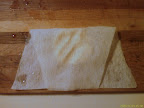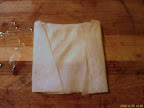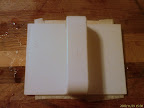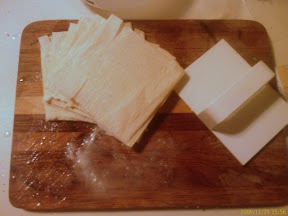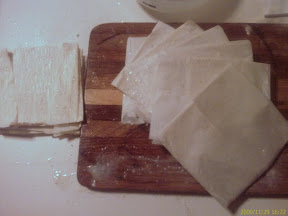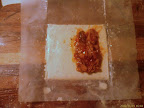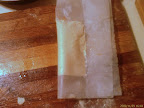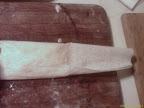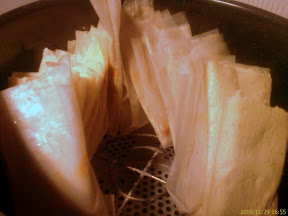I've heard enough good things about bone stock that I decided to try to make it. Over the years I've had mostly failures. It'd be too greasy, it'd have a terrible taste, or it just looked so bad I wanted nothing to do with it.
I broke it down to basics by going with what I know for menudo.(0) It contains at most one animal joint with some meat, hominy, and greasy gritty cattle guts. Since I've been eating it from babyhood, this is normal food. I don't enjoy the tripe, so I just put one big chunk in for the flavor and then dump it when the food is ready to serve.
So, back to the stock. I decided to start small, with a batch of drumsticks. Chicken legs don't have a whole lot of fat, and they have quite a bit of bone and some tasty meat.
I did all the standard things, and had the tools: a skimmer, cheesecloth, a spoon to catch the meat, and a cleaver for the bones. I really, really like marrow.
Taking the skin off was simple and it went well. I finally figured out that the foam that forms while it's boiling is a mixture of blood and fat, so that's why my earlier attempts had failed. I hadn't taken enough of it out. That stuff can be tasty, but not in stock.
Once I got the meat off the bones (and really forks and scissored tongs are the way to go with that). I chopped the big bones in half and tossed them back in the pot.
One neat trick I read was to put in a half cup of lemon juice. This lightens the flavor and the acid leaches more calcium off the bones. Whether that actually makes a nutritionally significant difference, I don't know. I do know that I can taste the difference when I've done it and when I haven't.
After having done that a few times, I mustered up my courage and added a chicken breast for more meat.(1) From there it was a simple step to getting the separate chicken parts, and then finally a whole chicken.
There are some good reasons for cutting up the chicken yourself:
- Bone bits - Commercially processed chicken is going to be full of little bone bits that you might or might not catch while digging the cooked meat out off the bones. This can also happen while you're cutting things up, but you're also not likely to be using a huge saw on a deadline while you're doing it.
- You get more meat. I was really surprised at this.
- Skin and fat for schmaltz and gribenes. (that's a whole other post. Or you can go here)
- Precut the meat into chunks, while still on the bone. I think the flavor gets in more, and you don't have as much work to do getting it off the bone later.
- A timer is essential. You want to cook the meat long enough for it to get flavored, but not so long it's rubbery and tasteless. I usually go for about an hour after the water starts boiling again.
- Take the meat's temperature.
- Don't be snobby - go ahead and use commercial bouillon to give it a good flavor. This is a great marriage saver.
I have a gallon. Of this stuff. On my stove. Now what?
I use it for lots of things. Most of it goes into the tortilla mix. I generally make tortillas three to four times a week. It takes about two weeks to use up all the stock, so I'll freeze half in a large container and just dip the measuring cup into the other container during the week. It takes about two days for the frozen stock to thaw in the fridge if you don't help it in the microwave.
Other uses are gravy, cheese soup (or really any soup that calls for a can of the soup and a can of water). I've cooked Ramen noodles, pasta, and steamed veggies with it in the microwave.
The really big hit is chicken enchiladas. After frying the tortillas, you'll have about a quarter cup of hot oil left over. Turn off the stove. pour in a half cup of stock, and chili powder to taste. If needed, add some flour to thicken. It takes about 15 minutes to settle in and mix well. Now you have delicious homemade enchilada sauce.
_____________________________
0. The word "menudo" translates to "small change", or really, "leftovers". More here.
1. January is absolutely the best month to buy chicken. Superbowl Sunday means everyone wants chicken wings, so the rest of the chicken gets sold at ridiculous prices. I got 10 pounds of chicken breast at $.39/lb. If I had a freezer, man...


